| Listing 1 - 10 of 64 | << page >> |
Sort by
|
Book
ISBN: 9780813547664 9780813547671 0813547679 0813547660 1780347901 9786613383174 0813549949 1283383179 Year: 2010 Publisher: New Brunswick, N.J. Rutgers University Press
Abstract | Keywords | Export | Availability | Bookmark
 Loading...
Loading...Choose an application
- Reference Manager
- EndNote
- RefWorks (Direct export to RefWorks)
The constellation of Hollywood stars burned brightly in the 1950's, even as the industry fell on hard economic times. Major artists of the 1940's--James Stewart, Jerry Lewis, and Gregory Peck--continued to exert a magical appeal but the younger generation of moviegoers was soon enthralled by an emerging cast, led by James Dean and Marlon Brando. They, among others, ushered in a provocative acting style, "the Method," bringing hard-edged, realistic performances to the screen. Adult-oriented small-budget dramas were ideal showcases for Method actors, startlingly realized when Brando seized the screen in On the Waterfront. But, with competition from television looming, Hollywood also featured film-making of epic proportion--Ben-Hur and other cinema wonders rode onto the screen with amazing spectacle, making stars of physically impressive performers such as Charlton Heston. Larger Than Life offers a comprehensive view of the star system in 1950's Hollywood and also in-depth discussions of the decade's major stars, including Montgomery Clift, Judy Holliday, Jerry Lewis, James Mason, Marilyn Monroe, Kim Novak, Bing Crosby, Gene Kelly, Jayne Mansfield, and Audrey Hepburn.
Film --- anno 1950-1959 --- United States --- Motion picture actors and actresses --- Acteurs et actrices de cinéma --- Biography --- Biographies --- Motion picture actors and actresses - United States. --- Music, Dance, Drama & Film --- Acteurs et actrices de cinéma --- United States of America
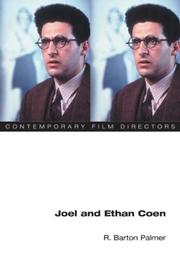
ISBN: 0252029364 0252071859 Year: 2004 Publisher: Urbana, Ill. University of Illinois Press
Abstract | Keywords | Export | Availability | Bookmark
 Loading...
Loading...Choose an application
- Reference Manager
- EndNote
- RefWorks (Direct export to RefWorks)
Coen, Joel --- Coen, Ethan --- Motion pictures --- Cinéma --- History --- Histoire --- Criticism and interpretation. --- film --- filmregisseurs --- Verenigde Staten --- Coen Joel --- Coen Ethan --- twintigste eeuw --- 791.471 COEN --- Cinéma --- History. --- Coen (ethan) --- Coen (joel)
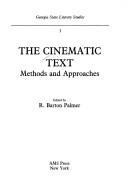
ISBN: 0404632033 Year: 1989 Publisher: New York, N.Y. AMS
Abstract | Keywords | Export | Availability | Bookmark
 Loading...
Loading...Choose an application
- Reference Manager
- EndNote
- RefWorks (Direct export to RefWorks)
Film --- Film criticism. --- Motion picture plays --- Motion pictures and literature. --- Motion pictures. --- Narration (Rhetoric) --- History and criticism. --- Narration (Rhetoric).
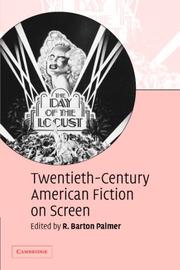
ISBN: 9780521542302 0521542308 9780521834445 0521834449 9780511610950 0511274378 9780511274374 0511272758 9780511272752 0511273541 9780511273544 9780511271113 0511271115 9780511270888 0511270887 9780511275074 0511275072 0511610955 1280815310 9781280815317 9786610815319 6610815313 1107161061 9781107161061 0511321228 9780511321221 Year: 2007 Publisher: Cambridge, UK New York Cambridge University Press
Abstract | Keywords | Export | Availability | Bookmark
 Loading...
Loading...Choose an application
- Reference Manager
- EndNote
- RefWorks (Direct export to RefWorks)
The essays in this collection analyse major film adaptations of twentieth-century American fiction, from F. Scott Fitzgerald's The Last Tycoon to Toni Morrison's Beloved. During the century, films based on American literature came to play a central role in the history of the American cinema. Combining cinematic and literary approaches, this volume explores the adaptation process from conception through production and reception. The contributors explore the ways political and historical contexts have shaped the transfer from book to screen, and the new perspectives that films bring to literary works. In particular, they examine how the twentieth-century literary modes of realism, modernism, and postmodernism have influenced the forms of modern cinema. Written in a lively and accessible style, the book includes production stills and full filmographies. Together with its companion volume on nineteenth-century fiction, the volume offers a comprehensive account of the rich tradition of American literature on screen.
American fiction --- Motion pictures and literature --- Roman américain --- Cinéma et littérature --- Film and video adaptations --- Adaptations cinématographiques et télévisées --- Film adaptations --- Film adaptations. --- History and criticism. --- Roman américain --- Cinéma et littérature --- Adaptations cinématographiques et télévisées --- American literature --- Arts and Humanities --- Literature
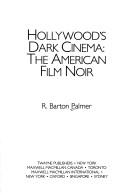
ISBN: 0805793356 0805793240 Year: 1996 Publisher: New York (N.Y.): Twayne
Abstract | Keywords | Export | Availability | Bookmark
 Loading...
Loading...Choose an application
- Reference Manager
- EndNote
- RefWorks (Direct export to RefWorks)
Film noir --- Films noirs --- History and criticism --- Histoire et critique --- Hollywood (Los Angeles, Calif.) --- History.
Book
ISBN: 9780813564098 9780813564081 9780813564104 9780813575490 0813564107 0813564093 0813564085 0813575494 Year: 2016 Publisher: New Brunswick, N.J. Rutgers University Press
Abstract | Keywords | Export | Availability | Bookmark
 Loading...
Loading...Choose an application
- Reference Manager
- EndNote
- RefWorks (Direct export to RefWorks)
In the early days of filmmaking, before many of Hollywood's elaborate sets and soundstages had been built, it was common for movies to be shot on location. Decades later, Hollywood filmmakers rediscovered the practice of using real locations and documentary footage in their narrative features. Why did this happen? What caused this sudden change? Renowned film scholar R. Barton Palmer answers this question in Shot on Location by exploring the historical, ideological, economic, and technological developments that led Hollywood to head back outside in order to capture footage of real places. His groundbreaking research reveals that wartime newsreels had a massive influence on postwar Hollywood film, although there are key distinctions to be made between these movies and their closest contemporaries, Italian neorealist films. Considering how these practices were used in everything from war movies like Twelve O'Clock High to westerns like The Searchers, Palmer explores how the blurring of the formal boundaries between cinematic journalism and fiction lent a "reality effect" to otherwise implausible stories. Shot on Location describes how the period's greatest directors, from Alfred Hitchcock to Billy Wilder, increasingly moved beyond the confines of the studio. At the same time, the book acknowledges the collaborative nature of moviemaking, identifying key roles that screenwriters, art designers, location scouts, and editors played in incorporating actual geographical locales and social milieus within a fictional framework. Palmer thus offers a fascinating behind-the-scenes look at how Hollywood transformed the way we view real spaces.
Film --- Los Angeles [California] --- Motion pictures --- Cinema --- Feature films --- Films --- Movies --- Moving-pictures --- Audio-visual materials --- Mass media --- Performing arts --- Scenery (Motion pictures) --- Setting (Motion pictures) --- Setting and scenery. --- Production and direction --- History --- History and criticism --- Art direction

ISBN: 9780521842211 9780511607554 9780521603164 9780511275135 0511275137 0511273622 9780511273629 0511274432 9780511274435 9780511271199 0511271190 9780511270819 051127081X 0511607555 128081537X 9781280815379 9786610815371 6610815372 0521842212 0521603161 0521603161 0521842212 1107163293 9781107163294 0511272839 9780511272837 0511320906 9780511320903 Year: 2007 Publisher: Cambridge New York Cambridge University Press
Abstract | Keywords | Export | Availability | Bookmark
 Loading...
Loading...Choose an application
- Reference Manager
- EndNote
- RefWorks (Direct export to RefWorks)
The process of translating works of literature to the silver screen is a rich field of study for both students and scholars of literature and cinema. The fourteen essays collected in this 2007 volume provide a survey of the important films based on, or inspired by, nineteenth-century American fiction, from James Fenimore Cooper's The Last of the Mohicans to Owen Wister's The Virginian. Many of the major works of the American canon are included, including The Scarlet Letter, Moby Dick and Sister Carrie. The starting point of each essay is the literary text itself, moving on to describe specific aspects of the adaptation process, including details of production and reception. Written in a lively and accessible style, the book includes production stills and full filmographies. Together with its companion volume on twentieth-century fiction, the volume offers a comprehensive account of the rich tradition of American literature on screen.
Film adaptations --- History and criticism --- American fiction --- 19th century --- Film and video adaptations --- American literature --- History and criticism. --- Film adaptations. --- Arts and Humanities --- Literature
Book
ISBN: 9780252054143 Year: 2004 Publisher: Champaign : University of Illinois Press,
Abstract | Keywords | Export | Availability | Bookmark
 Loading...
Loading...Choose an application
- Reference Manager
- EndNote
- RefWorks (Direct export to RefWorks)
With landmark films such as Fargo, O Brother Where art Thou?, Blood Simple, and Raising Arizona, the Coen brothers have achieved both critical and commercial success. Proving the existence of a viable market for "small" films that are also intellectually rewarding, their work has exploded generic conventions amid rich webs of transtextual references.R. Barton Palmer argues that the Coen oeuvre forms a central element in what might be called postmodernist filmmaking. Mixing high and low cultural sources and blurring genres like noir and comedy, the use of pastiche and anti-realist elements in films such as The Hudsucker Proxy and Barton Fink clearly fit the postmodernist paradigm. Palmer argues that for a full understanding of the Coen brothers'unique position within film culture, it is important to see how they have developed a new type of text within general postmodernist practice that Palmer terms commercial/independent. Analyzing their substantial body of work from this "generic" framework is the central focus of this book.
Book
Year: 2007 Publisher: Cambridge, UK Cambridge University Press
Abstract | Keywords | Export | Availability | Bookmark
 Loading...
Loading...Choose an application
- Reference Manager
- EndNote
- RefWorks (Direct export to RefWorks)
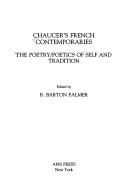
ISBN: 0404632106 Year: 1998 Publisher: New York, NY : AMS Press,
Abstract | Keywords | Export | Availability | Bookmark
 Loading...
Loading...Choose an application
- Reference Manager
- EndNote
- RefWorks (Direct export to RefWorks)
CHAUCER (GEOFFREY), d. 1400 --- FRENCH POETRY --- GUILLAUME DE MACHAUT, ca 1300-1377 --- MEDIEVAL AESTHETICS --- IDENTITE DANS LA LITTERATURE --- INFLUENCE --- TO 1500 --- CHAUCER (GEOFFREY), d. 1400 --- FRENCH POETRY --- GUILLAUME DE MACHAUT, ca 1300-1377 --- MEDIEVAL AESTHETICS --- IDENTITE DANS LA LITTERATURE --- INFLUENCE --- TO 1500
| Listing 1 - 10 of 64 | << page >> |
Sort by
|

 Search
Search Feedback
Feedback About UniCat
About UniCat  Help
Help News
News